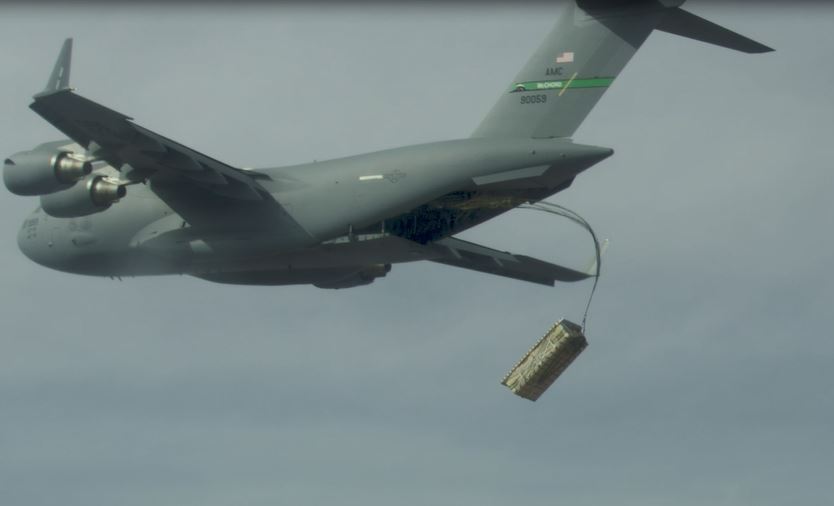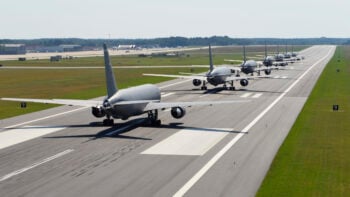
A high altitude airdrop of palletized munitions from a C-17 was conducted during the Air Force’s ABMS ‘On Ramp’ 2.
WASHINGTON: With its latest contract to Lockheed Martin, the Air Force Research Laboratory (AFRL) has taken another step in its effort to rapidly develop a capability to drop bombs and launch cruise missiles to augment the shrinking fleet of long-range bombers.
The Other Transaction Authority (OTA) contract, announced yesterday and worth $25 million over 18 months, represents the fourth phase of AFRL’s Palletized Munitions Experimentation Campaign, and builds on a series of previous experiments with palletized munitions using both an MC-130J and a C-17.
Lockheed Martin’s roll-on/roll-off pallet can carry up to 32 AGM-158B JASSM-ER (Joint-Air-to-Surface Standoff Missile-Extended Range) missiles on a C-17, Scott Calloway, program director at Lockheed Martin Missiles and Fire Control, told reporters today.
The effort is managed by AFRL’s Strategic Development Planning and Experimentation (SPDE, pronounced ‘speedy’) Office. SPDE sees the experimental program as an option for bringing “more mass to the fight” and for the service to shore up its long-range fires capability.
“This new contract that we were just awarded puts us on track for a system-level demonstration of that palletized JASSM deployment system from a cargo aircraft next year,” Calloway said.
“We’re working with the Air Force now to come up with that optimal payload, optimal load out,” he said. “But it’s largely a function of the deployment airdrop system, the missile being loaded onto the system, and the range of the aircraft is flying. Obviously, if a smaller munitions come online, I would expect that load out to increase without the need to design a new palletize munition system.”
Lockheed Martin also has one eye on future Advanced Battle Management System (ABMS) demos for testing its “box of cruise missiles,” Calloway said
“It’s not part of our baseline plan, but while we’re going through our test program next year we’ll definitely be looking for opportunities to synergize with ABMS,” he said.
The palletized munition system was used in the second ABMS “On-Ramp” demonstration Sept. 3. Targeting information was transferred “to an Air Force Special Operations Command aircraft via existing Beyond Line of Sight communications systems and cue the simulated release of a mock ‘palletized’ Joint Air-to-Surface Standoff Missile (JASSM),” according to an AFRL press release.
“Lockheed Martin, R4 Integration, and Naval Surface Warfare Center-Dahlgren were involved in the development effort for the first-of-its-kind demonstration. In a related event, the 412th Test Wing, in coordination with Air Mobility Command, conducted a C-17 palletized munitions airdrop demonstration using simulated munitions,” the Sept. 30 release added.
ABMS is the Air Force’s technology development effort designed to support the creation of a Joint All-Domain Command and Control (JADC2) network to enable military commanders to run future information-centric warfare across the air, land, sea, space and cyberspace domains.
Breaking D readers may remember that back in May, then-Maj. Gen. Clint Hinote said the Air Force wants to equip cargo planes with semi-autonomous stand-off weapons for long-range fires for All-Domain Operations. At the time, Hinote was deputy director of the Air Force Warfighting Integration Capability (AFWIC) office; in June he gained a star and now is deputy chief of staff for Strategy, Integration and Requirements at Air Force headquarters.
Hinote explained that in order for the concept of cargo planes carrying munitions to actually work, there would need to be a JADC2 network to figure out the availability of the aircraft for this secondary mission and sort out which missions would get priorities where and when.
AFRL further has been exploring new types of stand-off munitions that might make sense for deployment on cargo aircraft. The AFRL’s Jan. 28 experiment with the MC-130J at Dugway Proving Ground included drops of simulated Cargo Launch Expendable Air Vehicles with Extended Range (CLEAVERs), which AFRL has designed as potential “long-range, high precision weapons to destroy moving and non-moving targets.”
“The CLEAVER work started out as an Air Force program, where they were conducting some internal development of systems to be deployed by transport aircraft,” Calloway said. “That turned into this Pallitized Munitions concept. And we’ve been working with the Air Force on a series of usability, and analysis, and risk reduction efforts that have led to this most recent contract award.”






















